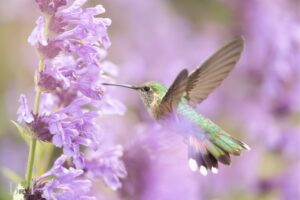When Do Rufous Hummingbirds Migrate? Early As January!
Rufous Hummingbirds typically begin their migration northward to their breeding grounds in the spring, starting as early as January from their wintering territory in Mexico. They reach the Pacific Northwest by March or April.
Come late June through August, these birds start their southward journey back to Mexico, with some traveling as far as 3,000 miles.
Rufous Hummingbirds are known for their remarkable long-distance migration, which is one of the longest of any bird species relative to body size.
The timing of their migration is influenced by several factors, including daylight, weather patterns, and floral sources along their route. During migration, Rufous Hummingbirds are solitary travelers and do not migrate in flocks.
Embarking on one of nature’s most incredible journeys, Rufous Hummingbirds navigate vast distances twice a year, showcasing the resilience of these tiny migratory marvels.

Key Takeaway
Rufous Hummingbird Migration Patterns
The Rufous Hummingbird migration patterns exhibit a remarkable annual journey across North America.
These tiny birds travel from their wintering grounds in Mexico and Central America to breeding grounds in the Pacific Northwest and Western United States, spanning a distance of over 3,000 miles.
Their migration typically begins in late winter or early spring, with the males arriving first to establish territories before the females join them.
Rufous Hummingbirds are known for their impressive flight capabilities, reaching speeds of up to 60 miles per hour during migration.
Their route takes them through diverse habitats, including coastal areas, mountain ranges, and urban environments.
Studying their migration patterns provides valuable insights into the ecological significance of these birds and the conservation of their habitats.
Factors Influencing Migration Timing
Migration timing in Rufous Hummingbirds is influenced by various factors. Climate and weather patterns play a significant role, as the availability of suitable conditions for flight and rest is crucial for successful migration.
Additionally, food availability and sources, as well as breeding and nesting behavior, also impact the timing of their migratory journeys.
Climate and Weather Patterns
Annually, Rufous Hummingbirds migrate in response to specific climate and weather patterns that influence their timing of migration.
These patterns include:
- Temperature: Rufous Hummingbirds are sensitive to temperature changes, and their migration is often triggered by the availability of suitable temperatures along their migratory route.
- Day Length: Day length is a critical factor influencing the timing of migration. Rufous Hummingbirds rely on the changing length of daylight hours to signal the start of their migration.
- Weather Patterns: Weather conditions, such as wind patterns and precipitation, play a crucial role in the timing of migration, as they can affect the availability of food and resources along the migration route.
Understanding these climate and weather patterns is essential for predicting and studying the migration behavior of Rufous Hummingbirds.
Food Availability and Sources
Influenced by the availability of nectar-rich flowers, Rufous Hummingbirds strategically time their migration to ensure access to essential food sources along their route.
These tiny birds rely heavily on nectar as their primary food source, making the timing of their migration highly dependent on the blooming of specific flowers.
The table below provides an overview of some key nectar-rich flowers that play a crucial role in the Rufous Hummingbird’s migration.
| Flower | Blooming Period | Geographic Location | Nectar Production |
|---|---|---|---|
| Indian Paintbrush | Late Spring to Summer | Western North America | High |
| Red Columbine | Spring to Early Summer | Western North America | Moderate to High |
| Honeysuckle | Spring to Summer | Western and Eastern NA | High |
| Scarlet Gilia | Summer | Western North America | Moderate |
Understanding the blooming periods and locations of these flowers is crucial in predicting the availability of nectar along the Rufous Hummingbird’s migration route.
Breeding and Nesting Behavior
During their migration, Rufous Hummingbirds time their departure and arrival based on their breeding and nesting behavior.
This behavior is influenced by several factors:
- Hormonal Changes: As the days lengthen and spring approaches, hormonal changes in the hummingbirds trigger breeding behavior. This includes courtship displays and territorial behavior.
- Nest Building: Female Rufous Hummingbirds meticulously build their nests using plant fibers, down, and spider silk. The availability of suitable nesting materials and the readiness of the females to build their nests play a crucial role in migration timing.
- Egg Laying and Incubation: Once the nest is built, females lay their eggs and begin incubating them. The timing of egg laying and incubation is another factor that influences when Rufous Hummingbirds commence their migration.
Understanding these breeding and nesting behaviors provides valuable insights into the timing of Rufous Hummingbird migration.
Spring Migration Routes
Spring migration routes of Rufous Hummingbirds are a crucial aspect of their annual cycle.
Understanding the timing of spring migration, preferred stopover locations, and the environmental factors influencing their journey is essential for conservation efforts and understanding the ecological significance of their migration.
By examining these points, we can gain valuable insights into the behavior and ecology of Rufous Hummingbirds during their spring migration.
Timing of Spring Migration
The timing of the Rufous Hummingbirds’ spring migration and their routes are crucial aspects of their annual journey.
Understanding the timing of their spring migration is essential for conservation efforts and tracking population trends.
Here are three key points regarding the timing of Rufous Hummingbirds’ spring migration:
- Early Spring Departure: Rufous Hummingbirds typically begin their northward migration from their wintering grounds in Mexico and Central America as early as late February, with peak migration occurring in March and April.
- Migration Routes: These hummingbirds follow specific routes during their spring migration, with the Pacific coast and Rocky Mountains being major corridors. Understanding these routes is vital for establishing protected areas and managing habitats along their migration path.
- Arrival in Breeding Grounds: Rufous Hummingbirds reach their breeding grounds in the Pacific Northwest and western Canada by late April to early May, where they establish territories and begin breeding activities.
Preferred Migration Stopovers
In their northward spring migration, Rufous Hummingbirds make strategic stopovers along their routes to replenish energy reserves and rest before continuing their journey.
These tiny birds typically prefer habitats with abundant nectar sources, such as flowering shrubs, gardens, and woodlands, for their stopovers.
Preferred migration stopovers include the Pacific Northwest, where they refuel on nectar from early-blooming flowers like red-flowering currant and salmonberry.
They also frequent mountain meadows and alpine areas with prolific wildflowers, providing essential nourishment for their long journey.
Additionally, coastal areas with rich floral resources, such as the Gulf Coast and California’s coastal regions, serve as crucial rest stops.
These stopovers are vital for Rufous Hummingbirds to successfully complete their arduous migration, ensuring they have the necessary energy reserves to reach their breeding grounds.
Environmental Factors Affecting Migration
During their migration, Rufous Hummingbirds are influenced by various environmental factors that shape their spring migration routes.
These factors include:
- Food Availability: The abundance of nectar-producing flowers along their migration routes significantly impacts the hummingbirds’ journey.
- Weather Patterns: The timing of their migration is influenced by weather conditions such as temperature, wind patterns, and precipitation. Favorable weather conditions facilitate their travel, while adverse weather can cause delays or alter their routes.
- Habitat Quality: The quality of stopover sites along their migration routes, including suitable nesting areas and resting spots, also influences the hummingbirds’ spring migration paths.
These environmental factors collectively shape the spring migration routes of Rufous Hummingbirds, guiding them towards their breeding grounds. In contrast, the fall migration routes are influenced by different environmental factors.
Fall Migration Routes
Navigating over 3,000 miles, Rufous hummingbirds embark on their fall migration routes, spanning from their breeding grounds in western North America to their wintering grounds in Mexico and Central America.
During fall migration, these tiny birds follow a specific route known as the Pacific Flyway.
This route takes them from their northernmost breeding grounds in Alaska and western Canada, down the western coast of North America, and onwards through Mexico to their wintering grounds in Central America.
Along this route, they traverse a variety of habitats, including coastal areas, mountain ranges, and tropical forests.
Rufous hummingbirds are known for their remarkable navigational abilities, using a combination of visual landmarks, the Earth’s magnetic field, and possibly celestial cues to guide their impressive journey.
Understanding these fall migration routes is crucial for the conservation and preservation of suitable habitats for these remarkable migratory birds.
Environmental Triggers for Migration
Embarking on their fall migration, Rufous hummingbirds are triggered by environmental cues that prompt their departure from their breeding grounds and guide them along the Pacific Flyway to their wintering grounds in Mexico and Central America.
Environmental triggers for migration include:
- Photoperiod: Shortening daylight hours signal to the hummingbirds that the seasons are changing, and it’s time to migrate south.
- Food availability: Decreasing nectar sources and insect abundance push the hummingbirds to seek more favorable foraging grounds.
- Hormonal changes: As the days shorten, hormonal shifts occur in the birds, compelling them to initiate migratory behavior.
These triggers collectively influence the timing and initiation of Rufous hummingbird migration, ensuring their timely departure for the wintering grounds.
Migratory Behavior Changes Over Time
As Rufous hummingbirds progress through their migration, their behavior undergoes notable changes in response to varying environmental conditions and resource availability.
Initially, during their northward migration in spring, the birds exhibit heightened territorial behavior as they compete for limited resources along their route.
As they continue their journey, their behavior shifts towards prioritizing foraging and refueling to support the strenuous flight.
This transition is crucial as the hummingbirds need to accumulate sufficient energy stores to complete their long migratory journey.
Once they reach their breeding grounds, their behavior shifts again towards courtship and nesting activities.
During the southward migration in fall, their behavior focuses on maximizing food intake to prepare for the upcoming long-distance flight.
These behavioral adaptations are essential for the survival and successful completion of the Rufous hummingbirds’ migration.
Challenges During Migration
During their migration, Rufous hummingbirds encounter numerous challenges as they navigate through changing environments and contend with limited resources.
These challenges include:
- Weather fluctuations: Rufous hummingbirds migrate over long distances, and they face unpredictable weather patterns such as storms and temperature changes, which can impact their ability to find food and shelter.
- Habitat loss: As they traverse their migratory routes, Rufous hummingbirds confront the loss of suitable habitats due to human development, deforestation, and other environmental changes, leading to a scarcity of resting and feeding locations.
- Competition and predation: During migration, Rufous hummingbirds must compete with other bird species for food sources and are also vulnerable to predation, adding further stress to their journey.
These challenges highlight the resilience and adaptability that Rufous hummingbirds must possess to successfully complete their migratory journeys.
Conservation Efforts for Migratory Birds
Rufous hummingbirds face ongoing challenges during their migration, necessitating frequent conservation efforts to ensure their survival and well-being.
Conservation organizations and researchers are actively involved in monitoring hummingbird populations along their migratory routes, identifying critical stopover sites, and implementing measures to protect these areas from habitat loss and degradation.
Collaborative efforts between governments, non-governmental organizations, and local communities are essential for the conservation of migratory birds like the Rufous hummingbird.
Conservation strategies include habitat restoration, establishment of protected areas, and public awareness campaigns to reduce threats such as urbanization, deforestation, and climate change.
Additionally, research into the behavior and ecology of Rufous hummingbirds during migration is crucial for developing targeted conservation initiatives that address specific challenges faced by these remarkable birds.
Conclusion
The migration patterns of rufous hummingbirds are influenced by a variety of factors, and their behavior changes over time as they adapt to environmental triggers.
Conservation efforts are crucial to ensuring the survival of these migratory birds, as they face numerous challenges during their long journeys.
Understanding their migration routes and timing is essential for implementing effective conservation strategies to protect these tiny but resilient travelers.
The rufous hummingbird’s migration serves as a symbol of the delicate balance between nature and human impact.






